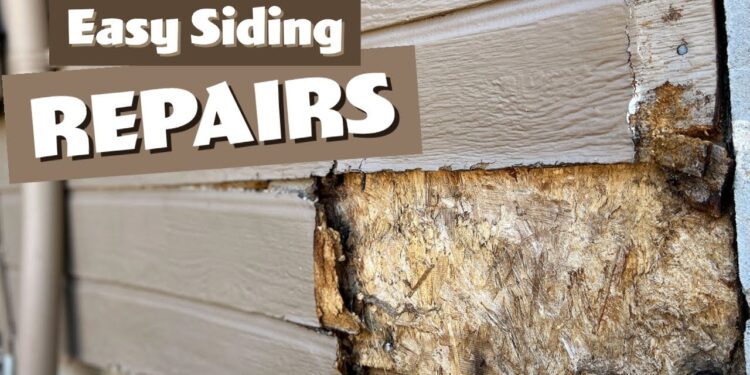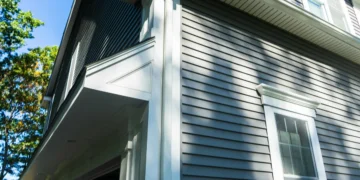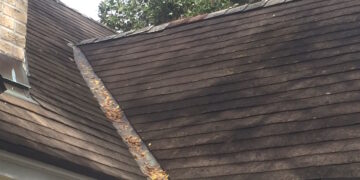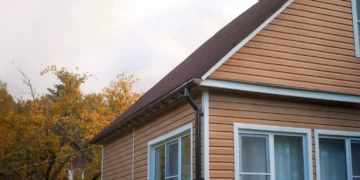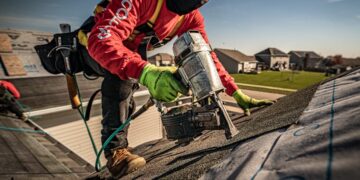Embark on a journey of repairing siding on your house, where we delve into the intricacies of fixing common issues with this essential component of your home. From identifying damage to painting and finishing, this comprehensive guide will equip you with the knowledge needed to tackle any siding repair project.
As we explore the different types of damage, tools and materials required, preparation steps, repair techniques, and finishing touches, you'll discover valuable insights to maintain the integrity and aesthetics of your house.
Types of Siding Damage
When it comes to house siding, there are various types of damage that can occur over time. These damages can be caused by a combination of factors, including weather conditions, age, and maintenance issues.Weather conditions play a significant role in the deterioration of siding.
Extreme heat, cold, rain, snow, and wind can all impact the condition of the siding, leading to damage such as cracks, holes, warping, or discoloration.
Cracks
Cracks in siding can be caused by a range of factors, including impact damage, age, and moisture exposure. These cracks can allow water to seep behind the siding, leading to further damage and potential mold growth.
Holes
Holes in siding can be a result of impact damage, pests, or deterioration over time. These holes can compromise the integrity of the siding, allowing moisture and pests to enter the walls of the house.
Warping
Warping of siding can occur due to prolonged exposure to sunlight and moisture. This can result in the siding becoming misshapen, which not only affects the appearance of the house but also its ability to protect the structure.
Discoloration
Discoloration of siding is often caused by exposure to UV rays, mold, or mildew. This can make the siding look old and worn, affecting the curb appeal of the house.
Tools and Materials Needed
To repair house siding, you will need a set of essential tools and materials to ensure a successful outcome. Additionally, safety equipment is crucial to protect yourself during the repair process.
Essential Tools
- Siding removal tool or pry bar
- Hammer
- Nails or screws
- Caulk gun
- Screwdriver
- Tape measure
- Utility knife
- Ladder
Specific Materials
- Vinyl siding: Replacement vinyl siding panels, matching color caulk
- Wood siding: Replacement wood siding boards, wood filler, paint
- Fiber cement siding: Replacement fiber cement siding panels, caulking compound
- Aluminum siding: Replacement aluminum siding panels, matching color paint
Safety Equipment
- Safety glasses
- Gloves
- Dust mask
- Work boots
- Protective clothing
- First aid kit
Preparation Steps
Before starting the repair work on the siding of your house, it is crucial to properly prepare the work area. This involves assessing the extent of the damage and thoroughly cleaning the siding surface to ensure a successful repair.
Assessing Damage
To assess the extent of the damage to the siding, carefully inspect the affected area. Look for signs of rot, decay, or warping. Pay attention to any cracks, holes, or loose pieces. By identifying the specific areas that need attention, you can better plan the repair process and gather the necessary materials.
Cleaning the Surface
Cleaning the siding surface is an essential step before beginning any repairs. Use a pressure washer or a mixture of mild detergent and water to remove dirt, grime, and debris from the surface. Ensure that the area is completely dry before proceeding with the repair work.
A clean surface will allow for better adhesion of new siding materials and improve the overall finish of the repair.
Repair Techniques
When it comes to repairing siding on your house, there are various techniques you can use depending on the type of damage. From simple fixes to more complex repairs, understanding the different methods will help you address any issues efficiently.
Fixing Cracks and Holes
One common issue with siding is cracks and holes that can develop over time
. To fix these, you can follow these steps:
- Clean the damaged area thoroughly to remove any dirt or debris.
- Apply a high-quality sealant to fill in the cracks or holes.
- Smooth out the sealant with a putty knife and let it dry completely.
- If needed, sand the area lightly to ensure a smooth finish.
Replacing Damaged Siding Panels
When a siding panel is beyond repair, you may need to replace it entirely. Here's how you can do it:
- Remove the damaged panel carefully, making sure not to cause further damage to surrounding areas.
- Measure and cut a replacement panel to fit the space precisely.
- Secure the new panel in place using nails or screws, depending on the type of siding.
- Seal the edges of the new panel to ensure a weatherproof finish.
Using Patches for Small Damages
For minor damages like small holes or dents, using patches can be a quick and effective solution. Follow these steps:
- Clean the damaged area and apply adhesive to the back of the patch.
- Place the patch over the damage and press firmly to ensure it adheres properly.
- Smooth out any air bubbles and allow the patch to set according to the manufacturer's instructions.
- Once the patch is secure, paint over it to match the rest of the siding.
Painting and Finishing
After repairing siding on your house, it is crucial to paint or finish the repaired areas to protect them from the elements and ensure a seamless look. The right paint or finish can help extend the life of your siding and improve the overall aesthetic appeal of your home.
Color Matching Techniques
When painting or finishing repaired siding, it's essential to match the color as closely as possible to the existing siding for a seamless finish. Here are some techniques for color matching:
- Take a small sample of the existing siding to a paint store for a custom color match.
- Use a color matching tool or app to find the closest match based on the sample you provide.
- Consider painting the entire section of siding to ensure a consistent color throughout.
Maintaining Painted Siding
Proper maintenance of painted siding is key to ensuring long-lasting results. Here are some tips to help you maintain your painted siding:
- Regularly wash your siding with a mild detergent and water to remove dirt and debris.
- Inspect your siding for any signs of peeling or chipping paint, and touch up these areas promptly.
- Consider applying a fresh coat of paint every few years to keep your siding looking its best.
Final Review
In conclusion, mastering the art of repairing siding on your house not only enhances its curb appeal but also ensures structural stability. By following the steps Artikeld in this guide, you can address siding issues effectively and prolong the lifespan of this vital feature of your home.
Question & Answer Hub
What are the common types of damage found on house siding?
Common types of damage include cracks, holes, warping, and discoloration caused by various factors.
What safety equipment is necessary for repairing house siding?
Safety goggles, gloves, and a dust mask are essential when working with tools and materials to repair siding.
How do you assess the extent of siding damage before starting repairs?
Inspect the siding carefully to identify the areas of damage, measure the affected sections, and determine the best repair approach.
Why is painting or finishing repaired siding important?
Painting or finishing helps protect the siding from weather elements and enhances its visual appeal, ensuring a longer lifespan.

